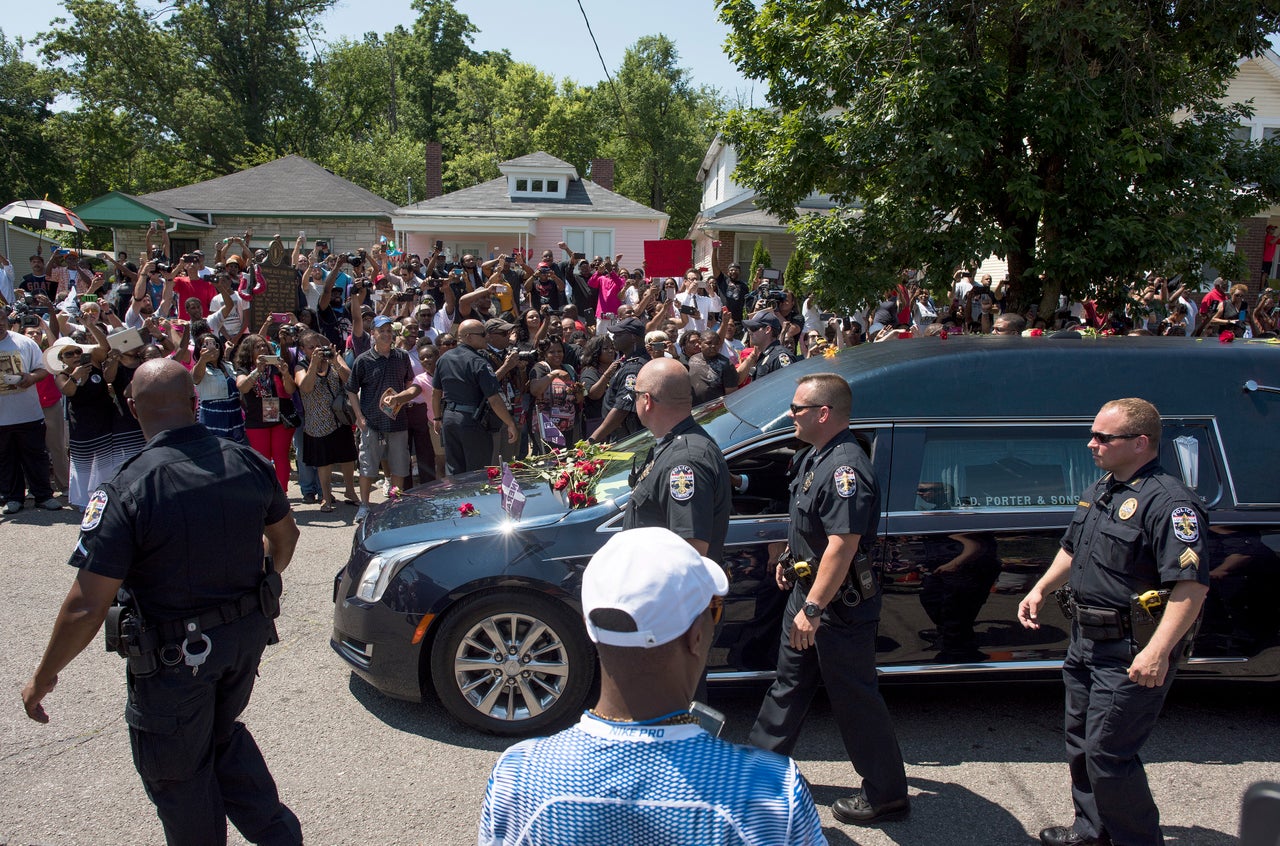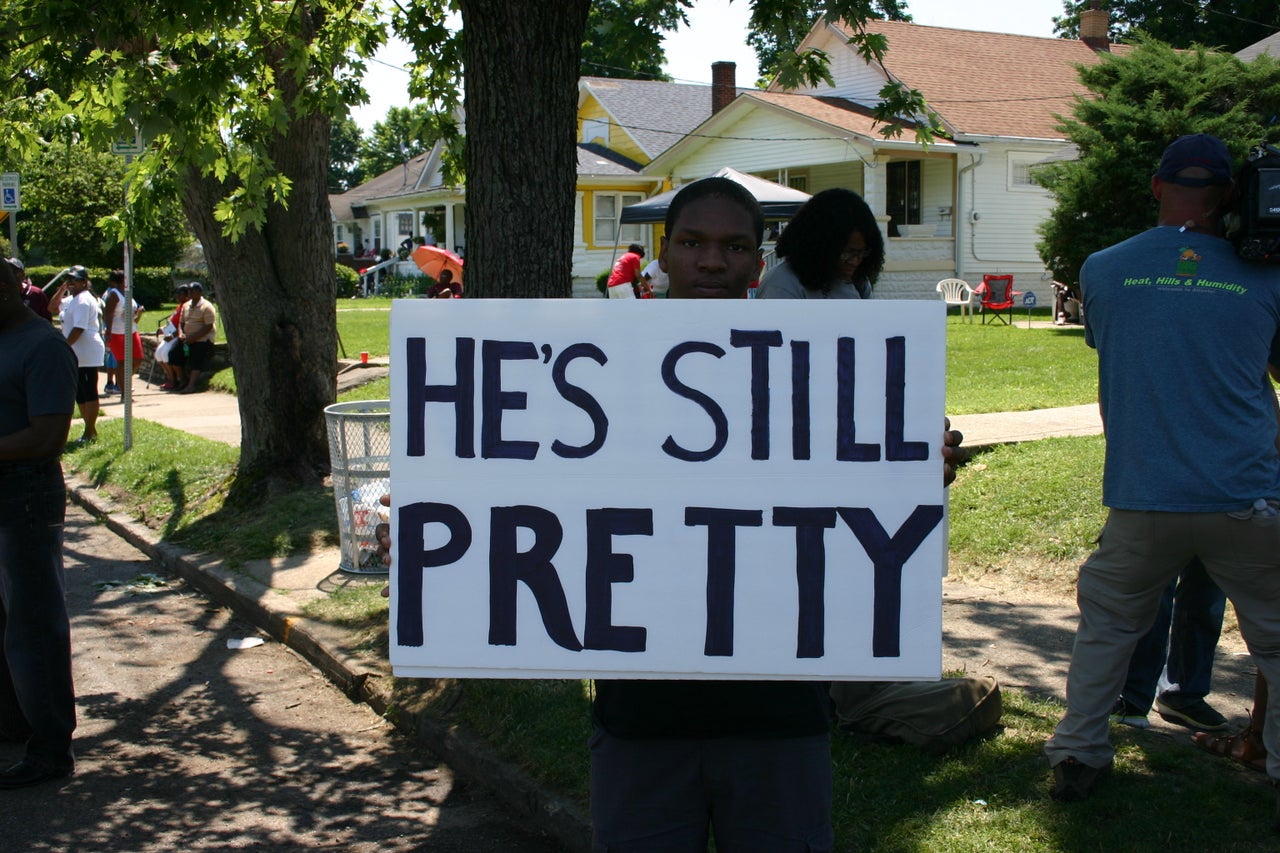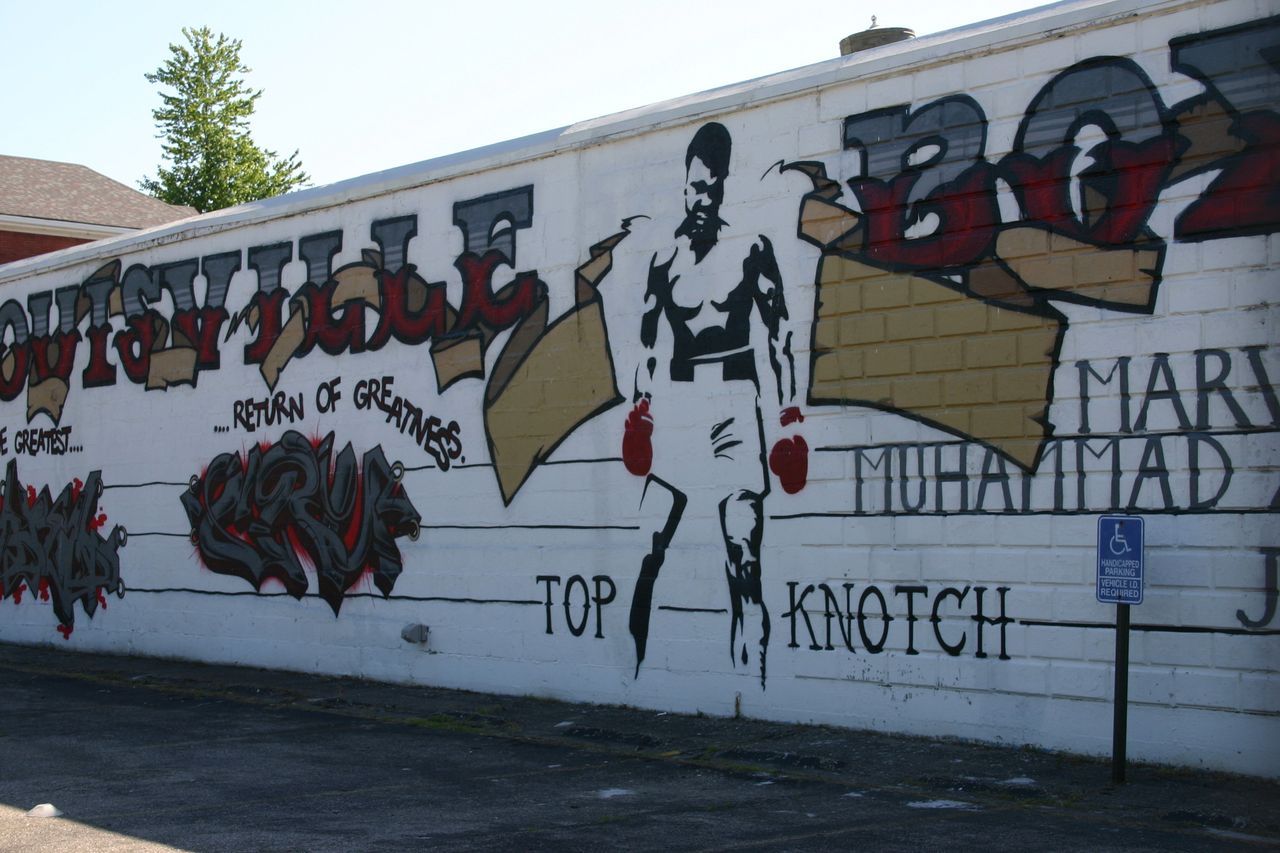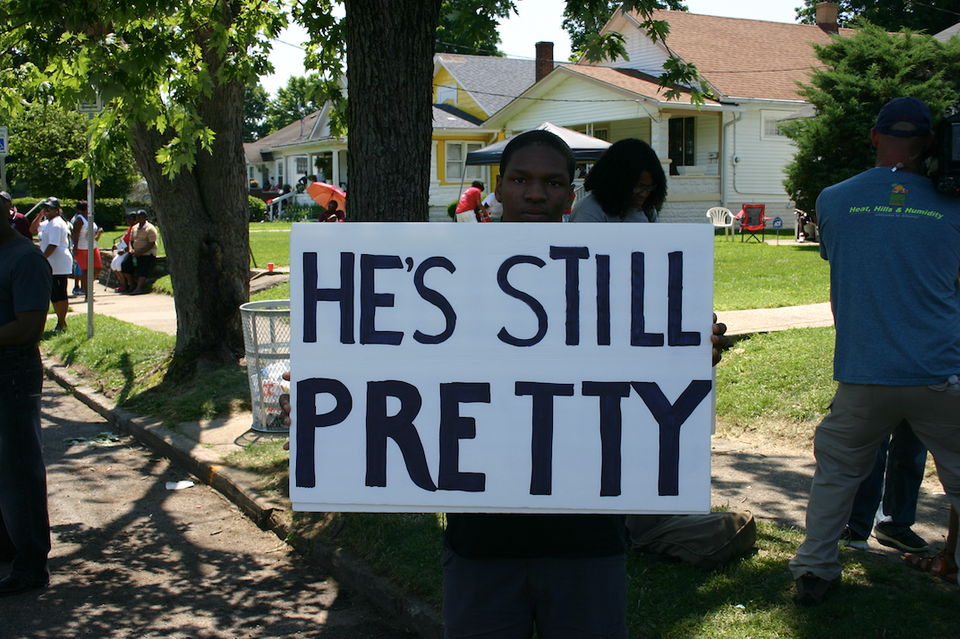LOUISVILLE, Ky. -- They flocked to Louisville from all over the world to pay last respects to Muhammad Ali a week after The Champ had died. A Nigerian from Venice Beach who spent a two-hour flight telling everyone around him how much Ali meant to him and the people of Africa. A woman from Ohio who, just days after hip surgery, had suffered four hours on the road to see Ali one last time. A man from Georgia who, in the airport the day after the ceremony, said he knew this was where he “had to be.”
They came to Louisville to mourn and celebrate the life of the city’s most famous icon, the boxing great who was a three-time heavyweight champion of the world inside the ring, and had an immeasurable political and cultural impact outside of it.
If any of the visitors were unaware of what Ali meant to his hometown before they arrived, they couldn't help but understand once there. Tens of thousands of people lined Bardstown Road, south of the city, for the start of a 19-mile processional that snaked through Louisville. An estimated 50,000 more waited for the processional along Muhammad Ali Boulevard and Broadway downtown. City workers in orange “I Am Ali” T-shirts were ubiquitous downtown; public buses changed their displays to read “Ali -- The Greatest." Banners marking his death flew from lampposts. Tributes were visible on theater marquees and in shop and restaurant windows across town.
A banner that declares him "Louisville's Ali" hangs from the side of the Louisville Gas & Electric building downtown, visible to travelers on both Interstates 64 and 65. It has been there for more than a decade, but its message was particularly poignant now: For the week following his death, the city and its most famous athlete had become inseparable.
It wasn’t always this way.
The Louisville of Ali’s birth was a city still plagued by Jim Crow, a town to which he, a black Olympic gold medalist, returned from Rome in 1960 to find he couldn’t sit in the same downtown restaurants as his white neighbors. Even as he shot to national and international fame, large swaths of white Louisville rejected Ali for his unflinching embrace of his blackness; for his conversion to Islam; for his resistance to the Vietnam War; and most of all, for challenging and questioning the racial status quo that white Louisville -- and white America -- had created and demanded he respect.
Ali's activism and outspokenness once sharply divided opinions of him in his hometown. And though the city united to celebrate Ali in the week following his death, there were still concerns among some in the African-American community that the city was celebrating a simpler version of its hero, one who became more ambassadorial and statesman-like in his later years, and whose boisterous voice was silenced by his fight with Parkinson's syndrome. Louisville has certainly changed since Ali's most controversial days, and its embrace of Ali reflects that. But it also seemed possible that this city-wide celebration could serve to paper over the many divides that Ali once challenged -- and that still exist today.
“There is a great danger of making Muhammad Ali our convenient hero,” said Dr. Kevin Cosby, the senior pastor at St. Stephen’s Church in West Louisville and the president of the historically black Simmons Bible College downtown. “Because then we can feel comfortable with the reinvented Ali, to continue to perpetuate the systemic evils that Muhammad Ali fought against."
"To do that," he added, "minimizes the courage of Muhammad Ali, and the purpose of his pronouncements.”

Cosby, like Ali, was a child of West Louisville, the side of town where most of the neighborhoods were, and still are, more than 90 percent African-American.
Cosby’s family moved east across town during his teenage years, and in 1971, he was one of the only black students at Waggener High School. That made him one of the few students in the school who took Ali’s side in his first bout with Joe Frazier.
“It was one of the most difficult times of my life,” Cosby said. “Most of the kids did not like Muhammad Ali, because their parents did not like Muhammad Ali, because he rejected white norms and standards.”
Seven years before that first Frazier fight, Ali had shed his given name, Cassius Clay, and joined the Nation of Islam. In 1967, he refused to join the military and became one of the most prominent resisters of the Vietnam War. Ali’s opposition was rooted in Islam, but it also flowed from his skepticism of fighting for a country that didn’t treat him or other African-Americans equally.
Ali might have been a Louisvillian. But his direct challenges to the city’s -- and America’s -- systemic white supremacy, and his outspokenness and unapologetic blackness, turned much of white Louisville against him.
“He was our Moses that landed.”
- Christopher 2X
Those feelings lingered after his retirement. In the late 1970s, when the city council launched an effort to rename a stretch of Walnut Street -- one of the main roads downtown -- after Ali, white business owners opposed the plan. They hid behind specious claims that it would cost them too much money to replace stationery and signage, and pushed city leaders to choose another alternative, like giving the street dual names or naming Central High School, Ali's alma mater, after him instead. The implication, as a letter from one black resident laid bare, was obvious: The businesses didn’t want their addresses associated with Ali, and pitched naming something in black Louisville after him instead to avoid it. Local citizens wrote to the Louisville Courier-Journal, whose editorial board and sports columnists supported the Walnut Street change, to complain that Louisville should name the street “Draft Dodger Boulevard.” One resident asked if the council planned to honor Adolf Hitler next.
But what made Ali a pariah to many whites had quite a different impact on African-Americans.
“Any accomplishment that a black person made from 1930 through 1960 chipped away at the mythology of white supremacy,” Cosby said. “It infused in the collective minds of African-Americans that we are not inferior, and it infused in African-Americans much-needed pride. In medieval theology, pride is one of seven deadly sins. In African-Americans, the absence of pride is the pre-eminent sin.”
That Ali was from Louisville only inspired more pride in the city’s African-American communities.
“Every time they would introduce him -- ‘From Louisville, Kentucky, the heavyweight champion of the world, Muhammad Ali’ -- for a black kid growing up, to hear Muhammad Ali connected with Louisville, Kentucky? A tremendous source of pride,” Cosby said. “Because I’m from Louisville, and he looks like me.”
When Ali came home in the 1970s for speaking engagements and other conventions, the crowds that greeted him were made up of “mostly young blacks,” as the Courier-Journal noted in a story about one such appearance. They couldn’t wait to see him in person.
“I believe wholeheartedly that we’ve always thought about him in our mind in trying times,” said Christopher 2X, a local community activist whose office sits on Muhammad Ali Boulevard in West Louisville. “A lot of us always thought about his fighting spirit as it related to our own lives and trials and tribulations.”
In West Louisville especially, 2X said, Ali "was our Moses that landed.”

The crowds began to gather in front of the little pink house on Grand Avenue, in the West Louisville neighborhood of Parkland, before 9 a.m. on the Friday morning of Ali’s funeral ceremony. All week, people from around the world had come to visit the house at 3302, where Ali lived as a boy. But on this day, the majority of the 1,500 or so people who swarmed the street were West Louisvillians themselves. Jackie Hughes waited along Grand Avenue with two friends under a homemade sign that read, like the banner downtown, “Louisville’s Ali!”
“He was inspirational, motivational, sensational. He meant the world to me,” Hughes said. “He gave a lot of people courage and hope.”
This was Ali's Louisville: West Louisville. Black Louisville.
And though the city as a whole has changed since the days he lived here as a boy, it doesn't require a deep dig to see the ways in which this part of Louisville has been left behind.
The county’s school system, which includes city schools, has earned national praise for its decades-long efforts to integrate. But that culture of integration hasn't extended to the rest of the city, even 50 years after it first instituted fair housing laws.
Nearly half of all Louisville residents live in neighborhoods that qualify as “extremely segregated,” according to a 2014 report from the Louisville Metro Human Relations Commission. Forty-eight percent of white Louisville residents, the report found, live in neighborhoods that are at least 95 percent white, while 40 percent of African-Americans live in areas that are at least 80 percent black.
The metro area as a whole -- which includes counties across the Ohio River in southern Indiana and those that border Jefferson County -- is the fourth-most segregated in the country, according to another survey.
Louisville’s black population, which makes up nearly 23 percent of Jefferson County’s 615,000 residents, is heavily concentrated in the city’s western neighborhoods. West of Ninth Street, decades of widespread disinvestment and policies that perpetuated the legacies of Jim Crow have created neighborhoods that are poorer, less educated and less healthy than the wealthier, primarily white neighborhoods to the east. Louisville's black unemployment rate is three times higher than the rate for whites, and these neighborhoods are also more exposed to pollution and violence. Last year, nearly half of all shootings and three-quarters of Louisville’s homicides occurred in the West End. Two-thirds of the victims were black.
“We integrated everything, or attempted to integrate everything, except what needed to be integrated: the power and the money."”
Even before Ali’s death, there were signs that Louisville’s political leadership was taking steps to address these issues, even if -- as acknowledged by both city officials and leaders in the black community -- that progress won’t be quick.
The Human Relations Commission report laid out a 20-year plan to address housing segregation, and last year, the city’s Democratic mayor, Greg Fischer, unveiled a $12 million plan to build 2,500 new affordable housing units, the first phase of a goal to build 24,000 such units over the next 15 years. The Louisville city council has also tried to update the area's housing codes to allow the development of more affordable housing, according to WFPL, a local news station.
Before the end of the year, the commission plans to release detailed maps of how and where redlining took place across the city. Carolyn Miller-Cooper, the executive director of Louisville’s Human Relations Commission, called it another step in the process of understanding “how we ended up where we are, and how we move forward and change this.”
In January, Cosby appeared on a panel at a forum about economic development in West Louisville, and challenged the city to have an “honest conversation about race.” Why, Cosby asked, had many of the economic development efforts in West Louisville targeted a traditionally white neighborhood, instead of seeking to create opportunities and promote black-owned businesses in African-American communities?
“We integrated everything, or we attempted to integrate everything, except what needed to be integrated: the power and the money,” Cosby told HuffPost.
Christopher 2X, whose Hood 2 Hood organization works with children in the hopes of reducing gun violence across the city, describes himself as “a realist” when it comes to racial progress in his hometown.
“We have to judge by the actions. And as of right now,” he said, pausing for a few moments and looking down at his desk, “we haven’t got there. We gotta work really hard. Those people who are really behind the eight ball, let’s try to connect, at least feel some of their pain. That was [Ali’s] message.”

Jazz tunes played over a loudspeaker on Grand Avenue in the hours before Ali's processional rolled by. A man who lived nearby pranced down the street, urging others to join him in “Ali, Bomaye!” chants. A young man who grew up here carried a painting of a proud, beautiful Ali -- he’d painted it just this week -- and said he’d donate it to the Muhammad Ali Center downtown. "He's Still Pretty," another sign read, playing off of one of his most famous declarations, "I'm pretty!" As the clock ticked toward noon and the procession fell more than an hour behind schedule, some called their bosses to say they might be late to work. To kill time, anyone with an Ali story shared it.
This was more of a celebration than a mourning -- and that the parts of Louisville that created Muhammad Ali remain underserved, underdeveloped and largely ignored only added significance to his life in this neighborhood and others like it. That was particularly true for the generations who hadn’t experienced The Greatest firsthand.
Last year in Smoketown, a poor neighborhood in the eastern part of downtown Louisville, James Dixon opened Louisville TKO, a gym just a few blocks from the one where Ali first trained. A mural of a defiant Ali in his most iconic pose is painted on one of its outside walls.
“It was very important to me when I opened this gym that I got to the right kids,” said Dixon, who is from Upton, Kentucky, but has lived in Louisville for two decades. “With the violence, the gangs, the drugs, I got tired of turning on the TV and seeing young men going off to jail, and shooting one another. I just knew they had to be exposed to something else.”
It was a deliberate choice to open the gym so close to where Ali got his start. Dixon wants to share Ali’s message through boxing.
“Every kid’s not going to make the Olympic team. Every kid’s not going to become a champion,” Dixon said. “But you can become a world-class citizen.”
The morning of Ali’s ceremony, Robert Cox paused while taking out the trash in front of his house, on 32nd Street just around the corner from Ali’s former home, and ran back inside.
He returned holding a worn manila envelope filled with two dozen original black and white images of Ali fighting in the 1960s. Jagged on the edges and yellowed from age, the pictures were so fragile it felt they might disintegrate if handled at all. Cox, 42, hadn’t seen Ali fight himself, but his father loved The Champ so much he gave Robert “Ali” as a middle name. In the days after Ali’s death, Cox began to pass his father’s stories down to his own son.
“I’m just letting him know: It’s easy to get out here, easy to get caught up, easy to quit. But knowing about Muhammad Ali, thinking about the things he’s accomplished, you’ve just gotta keep pushing,” Cox said. “Keep fighting and pushing and trying to do the right thing, and speaking up. That’s the only way to really win. “
On Grand Avenue, a dozen black children gathered under a tree that provided respite from the beating sun. “Ali Is Parkland,” read a sign they held. For an hour, they chanted: “Float like a butterfly, sting like a bee. R-I-P, Muhammad Ali.”
The children came to Grand Avenue from the Parkland Boys & Girls Club just a block away. Ebonne Ingram-Jones, the club’s unit director, spent the week after Ali’s death teaching them about The Greatest. None of them had seen Ali fight or lived through the racial and political tumult of the '60s. Still, Ali resonated.
“We oftentimes take for granted identity, and what it means to know that you are a part of something greater than yourself, and that you are connected to someone who has done great things,” said Ingram-Jones, who, like Ali, is a Central High graduate. “I brought these children here not only to recognize such an influential and dynamic person, but to give them the opportunity to identify with greatness, and to see Ali in themselves.”
Finally, word came that the procession was near, and a raucous chant broke out as the processional finally turned off of 34th Street toward Muhammad Ali’s old home.
“Ali! Ali! Ali!”
The throngs were so thick, the urge to push onto the pavement for the best view of The Champ so strong, that the limousines that carried his family could barely pass.
The crowd that had endured the hottest day of the year so far for one last glimpse of their biggest local hero followed the processional around the corner when it turned on to 32nd Street. “Thank you for sharing him with us,” a man yelled to the car that carried Ali’s wife, Lonnie, and daughter, Laila, herself a heavyweight champion.
There were smiles and laughter and tears for the man who’d come back after never really leaving. And then, Ali was gone from this part of West Louisville for the last time. His last visit home had lasted just a few minutes.
“Back to normal,” someone yelled.
CORRECTION: This story originally misstated the name of the street changed to Muhammad Ali Blvd. It was Walnut St., not Chestnut St. We regret the error.

